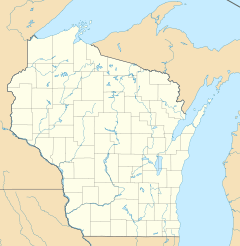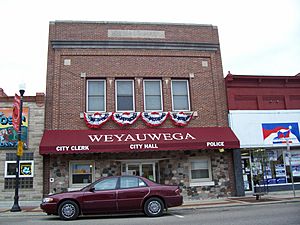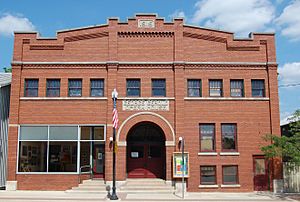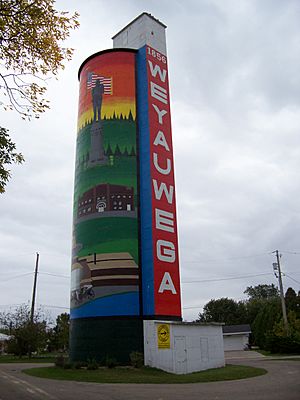Weyauwega, Wisconsin facts for kids
Quick facts for kids
Weyauwega
|
|
|---|---|
|
City
|
|
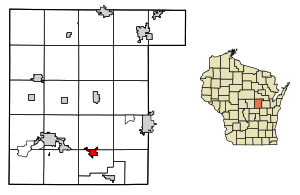
Location of Weyauwega in Waupaca County, Wisconsin.
|
|
| Country | |
| State | |
| County | Waupaca |
| Incorporated (city) | April 15, 1939 |
| Area | |
| • Total | 1.66 sq mi (4.30 km2) |
| • Land | 1.54 sq mi (3.98 km2) |
| • Water | 0.12 sq mi (0.32 km2) |
| Population
(2010)
|
|
| • Total | 1,900 |
| • Estimate
(2019)
|
1,761 |
| • Density | 1,146.48/sq mi (442.71/km2) |
| Time zone | UTC-6 (Central (CST)) |
| • Summer (DST) | UTC-5 (CDT) |
| ZIP codes |
54983
|
| Area code(s) | 920 |
| FIPS code | 55-86400 |
| Website | www.cityofweyauwega-wi.gov |
Weyauwega is a city located in Waupaca County, Wisconsin, in the United States. In 2010, about 1,900 people lived there. People who live in Weyauwega often call it "Wega" for short.
The name "Weyauwega" might mean "Here we rest" in an old local indigenous language. This is because the area was once a resting spot for Native Americans who were moving their canoes between two rivers. The Menominee language might be the source of this name.
Long ago, European fur traders set up a small building here. This was the start of the town that grew into the city we know today.
Contents
Where is Weyauwega?
Weyauwega is located at 44°19′N 88°56′W / 44.317°N 88.933°W. It covers about 1.71 square miles (4.43 square kilometers). Most of this area is land, with a small part being water.
How Many People Live Here?
| Historical population | |||
|---|---|---|---|
| Census | Pop. | %± | |
| 1880 | 722 | — | |
| 1890 | 706 | −2.2% | |
| 1900 | 911 | 29.0% | |
| 1910 | 967 | 6.1% | |
| 1920 | 938 | −3.0% | |
| 1930 | 1,067 | 13.8% | |
| 1940 | 1,173 | 9.9% | |
| 1950 | 1,207 | 2.9% | |
| 1960 | 1,239 | 2.7% | |
| 1970 | 1,377 | 11.1% | |
| 1980 | 1,549 | 12.5% | |
| 1990 | 1,665 | 7.5% | |
| 2000 | 1,806 | 8.5% | |
| 2010 | 1,900 | 5.2% | |
| 2019 (est.) | 1,761 | −7.3% | |
| U.S. Decennial Census | |||
Population in 2010
In 2010, the city had 1,900 people. Most of the people living in Weyauwega were White (96.4%). About 6.1% of the population identified as Hispanic or Latino.
The average age of people in the city was about 38 years old. About 25% of the residents were under 18 years old.
Getting Around Weyauwega
Weyauwega is on Wisconsin Highway 110. Other important roads, like U.S. Route 10 and Wisconsin Highway 49, are just south and west of the city.
A historic road called the Yellowstone Trail used to run through Weyauwega. You can still see signs marking its old path in the downtown area.
Schools in Weyauwega
The city is part of the Weyauwega-Fremont School District. This district has about 963 students. It includes a high school, a middle school, and two elementary schools. One elementary school is in Weyauwega, and the other is in nearby Fremont, Wisconsin.
There is also a private school called St. Peter Lutheran School. It teaches students from 3K (preschool) up to 8th grade. This school is part of the Wisconsin Evangelical Lutheran Synod.
A Look at Weyauwega's History
Weyauwega has some interesting traditions and events.
Horse and Buggy Days
Since 1961, Weyauwega has hosted an annual event called Horse and Buggy Days. This event celebrates the past importance of horses and buggies in the community. It includes a parade, music, and other fun activities. The Weyauwega Chamber of Commerce organizes this event.
Waupaca County Fair
The Waupaca County Fair has been held in Weyauwega since 1874. It takes place at the Waupaca County Fairgrounds, which is on the east side of the city.
1996 Train Incident
In 1996, a freight train had an accident in Weyauwega. This caused a large fire. As a safety measure, everyone in the town had to leave their homes for two weeks. They could return once the fires were out and the area was safe.
Famous People from Weyauwega
Many notable people have connections to Weyauwega:
- Albert V. Balch – A representative in the Wisconsin State government.
- Lyman E. Barnes – A U.S. Representative for Wisconsin.
- Benjamin P. Birdsall – A U.S. Representative for Iowa.
- Robert Bloch – An author, famous for writing the novel Psycho.
- Mark Block – A chief of staff for a presidential campaign.
- Eliada W. Brown – A member of the Wisconsin State Assembly.
- George de Rue Meiklejohn – A U.S. Representative for Nebraska.
- Sona (Hunter) Mehring – The founder of CaringBridge, a website for sharing health updates.
- George S. Merry – A state representative in South Dakota.
- William E. Merry – A state legislator in South Dakota.
- Hallie H. Rowe – A member of the Wisconsin State Assembly.
See also
 In Spanish: Weyauwega (Wisconsin) para niños
In Spanish: Weyauwega (Wisconsin) para niños


